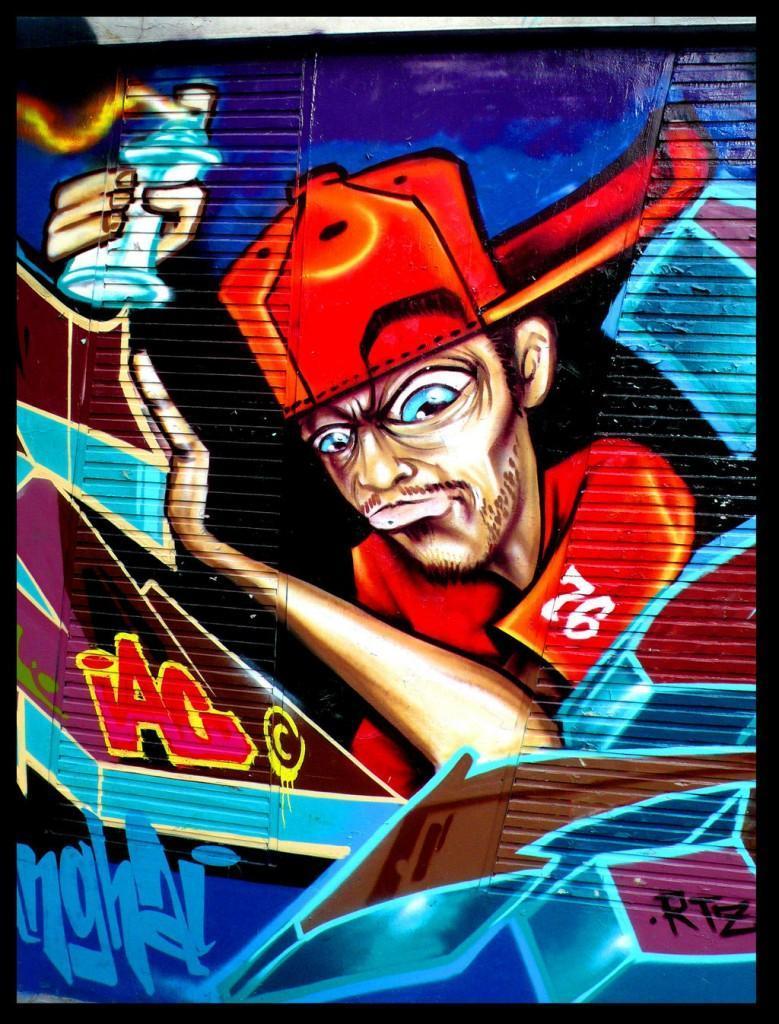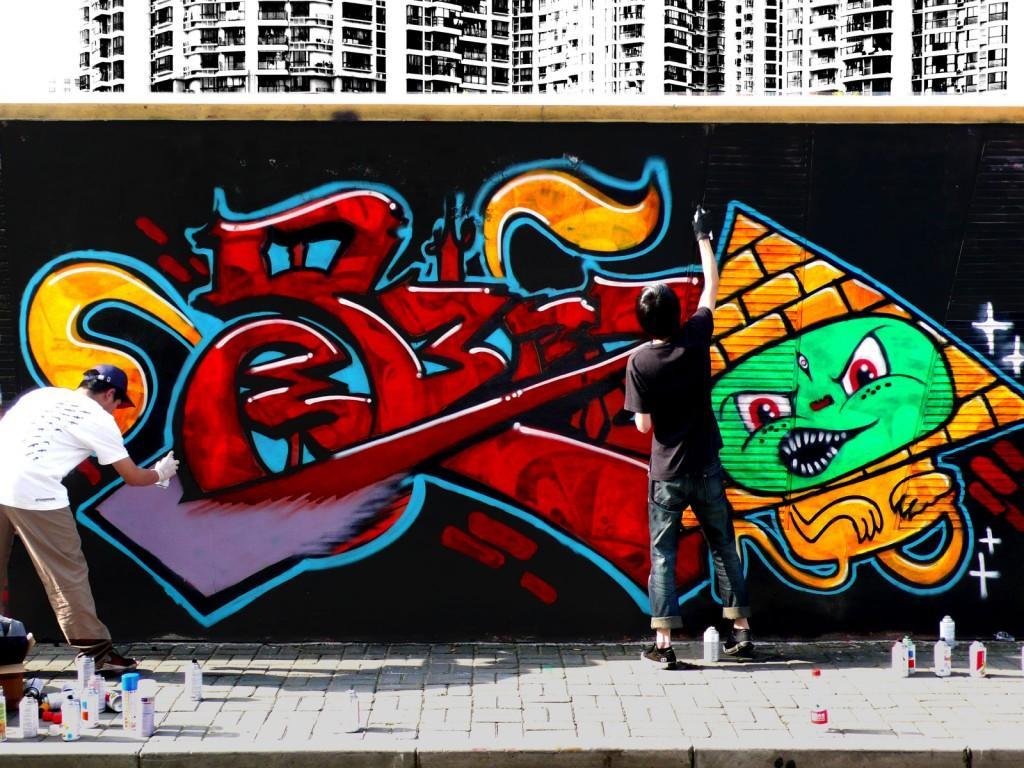Graffiti writers, graffiti culture and subculture, graffiti writing
Graffiti writers, subcultural graffiti or graffiti subculture are just over 30 years old. Originally from New York City, it has developed synergistically with hip-hop dance and music culture and now enjoys the status of a global phenomenon.
 The graffiti subculture has its own status structure, its own criteria for referring people to this and its symbolic, but highly valued awards. What sets her apart from many other youth groups or subcultures is her outspokenness, her open acknowledgment of her own point of view and purpose. Fame, respect and status are not natural by-products of this subculture, they are its only reason for being and the only reason for the writer to be here.
The graffiti subculture has its own status structure, its own criteria for referring people to this and its symbolic, but highly valued awards. What sets her apart from many other youth groups or subcultures is her outspokenness, her open acknowledgment of her own point of view and purpose. Fame, respect and status are not natural by-products of this subculture, they are its only reason for being and the only reason for the writer to be here.
Graffiti as a profession
Graffiti writers aren't particularly open about what they're doing, and the tabloid press, which comments more than most, rarely tells the whole story. The experience of a graffiti writer in this subculture is very structured. Most follow a set route or career, if you will.
Like an employee of a large company, graffiti writers start their careers at the bottom of this ladder and work hard to work their way up. The higher they climb, the greater the obvious reward. Apart from the similarities, some important differences do separate them:
– Graffiti writers are younger than most employees, and their careers are much shorter.
– The career of graffiti writers usually does not bring material benefits: they do not receive material remuneration, their work is a reward.
Glory and respect, these are the two driving forces. Graffiti culture translates financial reward into symbolic capital, namely fame, recognition or respect of the whole society.
Strangers. Symbolic or not, this is a very valuable wage in graffiti culture. As writers gain fame and respect, their self-esteem begins to change. In the beginning, when graffiti writers start graffiti, they are more or less like "nobody" and they are just working on becoming somebody. In this light, a writing career could be better.
described as a moral career. If a moral career can be defined as structures for self-affirmation available in youth culture, then graffiti represents a moral career in its purest form. Gaining respect, fame, and strong self-esteem is openly expressed as the main goal of the graffiti writer, and the subculture is fully tuned in to support this goal.
Writers face the same difficult career climb as anyone striving for success. The only difference is that they probably put in a lot more overtime. A graffiti career is not a nine-to-five calling.
graffiti writer career path
Seeing an ad
Graffiti involves the public writing of one's name or "tag": each graffiti author had his own tag, something like a logo in an advertisement. These names, "tags," are visible as advertisements written on the walls of your driveway/block, or perhaps along the street or subway/metro route that you use to get to school each day. It is this repetitive exposure that seems to pique the interest of the new graffiti writer. Instead of blending into the background, the names pop up and become familiar. Recognizing these names, new graffiti writers begin to realize the essence of the subculture - fame. They are also presented with a challenge element. The graffiti-covered walls and surfaces of the city act as a form of subcultural advertising. They tell the aspiring graffiti writer what can be achieved with a little time, effort, and commitment, and provide guidance on how to achieve those goals.
Name selection
Having shown interest, graffiti writers must now choose the name or "tag" they plan to use. The name is the basis of graffiti culture. It's the most important
aspect of the job of a graffiti writer and the source of his fame and respect. Graffiti is illegal, so writers usually don't use their real names. The new name also gives them a new start and a different identity. Writers choose their names for a variety of reasons. Every writer will try to find and keep the original name, and ownership claims are not uncommon. While most writers have one primary name, very "active" illegal writers with high police standing may "have a different name, so if one name was popular, wanted by the authorities, they would write under a different name."
Occupational Hazards
Illegal graffiti involves glorifying yourself. Individual graffiti writes his name and actually says "I am", "I exist". However, in the culture of graffiti, it is not enough just to “be”, “to exist”. You need to be and exist in style. Style is a centrally important part of graffiti. The way you write your name, the letters you use, their shape, shape and form, the colors you choose, all create the "style" of the writer. And other writers will judge you, often harshly, on that basis. By slowly developing skills, graffiti writers avoid the risk of criticism from peers. In fact, they overcome one of the "dangers" that make up a "moral career." These are, in essence, cases "in which a man may win the respect or risk the contempt of his fellows". Ego is at stake here, and new graffiti writers take no chances. Most will start by practicing their skills on paper at home.
Making an entrance
Although some older graffiti writers work legally, working in galleries or paying commissions, most start and maintain illegal careers. Illegality is a natural starting point for a new graffiti writer. First of all, their interest in graffiti is usually caused by viewing the work of other illegal authors. Secondly, adventure, excitement, and liberation from illegal exercise play a big part in getting their attention in the first place.

Create a name
The claim to fame is called "name making" and there are three main forms of graffiti that graffiti writers can use to do so; tag, toss and piece. These are all variations of a name and, at a basic level, involve one of two actions - the stylistic or fruitful spelling of that word. Writers may use these different forms of graffiti, and with it different paths to fame, but their careers tend to follow a fairly standard pattern: usually every graffiti writer starts on paper, works on drawing and bombing, and then works on to make parts and they get better as they go on. Following the practice of their skills on paper, graffiti writers usually start by "marking" or "bombing", that is, putting their name as a signature. Tagging is the easiest place to start. As the graffiti artist progresses, he will likely begin to experiment and "get up" using other forms of graffiti.
Promotion piece
A graffiti writer with experience, skills, and a desire to tackle more challenging tasks is likely to end his career to a more relaxed level as an artist. The play, short for "masterpiece", is a larger, more complex, colorful, and stylistically demanding depiction of the writer's name. Thingers deal with more complex and time-consuming projects, so their work is judged not by quantity, but by quality. This is where "style" comes into play as a central component of writing. As writers move on and look for new ways to promote and expand themselves, tags are taking a bit of a backseat. It can still be used to maintain a writer's profile, but it is losing its place as a vocation.
Space travel
To earn fame, graffiti writers need an audience. Accordingly, the places where they draw are usually clearly visible. Places such as highways, overpasses, bridges, street walls, and railroad tracks are great for drawing public attention to the work of graffiti artists. However, the best canvas for their work is one that moves, expanding their audience and the reach of their name. Buses and trucks are popular targets for graffiti. However, the ultimate means of transport will always be the subways/underground trains.
Career shifting
When a graffiti writer reaches the higher levels of a subculture's status hierarchy, the pace of his/her career begins to stabilize. Through the recognized stages of subculture activity, writers can make justified changes in their identity. This flexibility allows them to overcome the difficulties of their illegitimate position and indeed avoid them when they become too much.
Law
At a certain age or stage in life, graffiti writers can find themselves at a crossroads. On the one hand, they have "real" responsibilities that begin to demand more of their time, money, and attention. On the other hand, they have an illegal occupation that they cherish but cannot harmonize with their current lifestyle. Commercial legal work takes writers out of the subculture. They no longer paint for their peers or for themselves, they now have a new audience; a person or business buying their work.
Graffiti photos from http://sylences.deviantart.com/
Leave a Reply